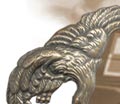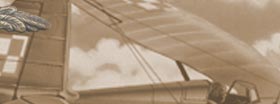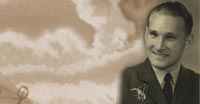The Polish nation re-emerged in 1918 after 123 years of obscurity
and subjugation by Germany, Russia or the Austro - Hungarian Empire.
While the Poles quickly implemented political and economic systems
to attain 'nationhood,' external forces were quick to seize any
opportunity to test Poland's strength while there was a vacuum
in Central and Eastern Europe. Within three years of its re-emergence,
Poland had fought forces from Germany, Lithuania, the Ukraine
and Russia over the sovereignty of land. While Polish politicians
like Dmowski wanted frontiers based upon ethnic boundaries, many
Poles sought the former glory of the Polish - Lithuanian Commonwealth
which had existed at the end of the eighteenth century. The 'Polish
Question' had dogged politicians both during war and at the Treaty
of Versailles. Friction caused by complex ethnic boundaries and
contested cities, ultimately led to the outbreak of war.
Prologue to War
The fledgling parliament (Sejm) passed the Army Law in February
1919 and appointed Jozef Pilsudski as commander - in - chief.
The inter-war army was initially a 'motley-crew' of units largely
made up of prisoners of war from German and Austro-Hungarian army
or small political militias (Ascherson, 1987; Zaloga and Madej,
1991). Historically, Poland had provided the elite cavalry for
Napoleon and this relationship had ironically been maintained
in both the First and Second World Wars.
In France, General Jozef Haller had commanded six divisions of
the Polish Army during the 1914 -18 War and other units had been
attached to the French Foreign Legion. At the outbreak of war
25,000 Polish-Americans had volunteered to fight in the trenches.
These volunteers were trained in Canada while the USA languished
in neutrality. (The Haller Army was transferred to Poland in 1919).
The tsarist government had also allowed the formation of a Polish
Legion (Pulawy Legion). However, increasing political tension
within Russia and fears of growing Polish nationalism, saw it
disbanded until the more liberal regime of Kerensky in 1917 enabled
the formation of the 1st Polish Eastern Corps and transferred
to the front in Byelorussia.
Pilsudski commanded an army trained by its adversaries and commanded
by an officer corps drawn largely from the old Austro - Hungarian
Empire that led to tension within the armed forces. Many of these
units consisted of up to 40% non-Polish ethnic origin (Zaloga
and Madej, 1991).
As Poland regained its nationhood, border skirmishes enabled
the 'new army' to emerge as a more cohesive unit. The 1920 - 21
Polish - Soviet War was a brief but terrifying moment for the
whole of Europe (Ascherson, 1987, Stafford, 1997). To numerous
observers, the Poles were about to achieve what the White Russians
had not - the overthrow of the Bolsheviks (Stafford, 1997).
Churchill had seen and hoped to have funded the campaign by Savinkov,
an anti - Tsarist and anti - Bolshevik Russian for a campaign
to thwart the rise in communism. The 'Greens' or Union for the
Defence of the Motherland carried out a series of sabotage operations
against rolling stock, ambushing Bolshevik patrols and organized
the assassination of leading local Bolsheviks within Russia. Pilsudski
supported Savinkov who was unaware that the Cheka had penetrated
his organization. White Russians still envisaged Poland being
reabsorbed into the Russian Empire and this fundamental political
stance negated any support Pilsudski may have given.
In April 1920 Poland supported the Ukrainian nationalist forces
and invaded the Ukraine. The operation was so successful with
Polish cavalry units pushing towards Kiev that the humiliated
Soviets sought retribution. With the White Russian Army quashed,
the Soviets pushed the Poles back to the gates of Warsaw. By the
end of the summer 1920, Pilsudski had engineered a brilliant counterattack
(Zaloga and Madej, 1991) and pushed the Soviets back to the border.
Russian peasant revolts in Tambov and the Kronstadt mutiny caused
by famine, forced Lenin to alter his economic 'reforms' and with
an embarrassing defeat, bided his time. Poland's military ability
did not deter Czechoslovakia from seizing a contested strip of
territory near the city of Cieszyn. In the run up to the Second
World War, Poland was bordered by neighbourly disputes that appeared
unsolvable. State of the Armed Forces
Much of the First World War's Eastern Front had been fought over
Polish soil. Previous imperial powers had stripped agricultural
resources and made no industrial investment apart from a few textile
factories in Lodz. The Polish State was in a dire economic situation.
While the fledgling democracy had flexed its political and military
muscles, the economy was a shambles.
Military training and support came from France. French officers
training and theory favoured a strategy of static attrition. To
lessen French influence, Pilsudski requested their departure in
the late 1920s (Zaloga and Madej, 1991). Political infighting
along ethnic and party lines resulted in a coup d'etat in 1926
by Pilsudski. Industrialization in southern Poland had enabled
the Poles to produce fighter aircraft (P.7 and P.11) superior
to contemporary German and Russian designs, however, these were
largely shipped abroad to countries like Romania, Bulgaria, Greece
and Turkey for foreign exchange earnings to fund the economy.
Funding of the armed services represented 10% of the German Luftwaffe's
1939 budget (Zaloga and Madej, 1991:11)
|
Polish Defence Budget 1938 - 1939 |
| Service |
Millions
Zloty |
% |
| Military
administration |
100 |
12.5 |
| Infantry |
225 |
28.2 |
| Cavalry |
58
|
7.3 |
| National
Guard |
7
|
0.9
|
| Artillery
|
16
|
2 |
| Armored
Force |
13.7 |
1.7 |
| Engineers |
8.9 |
1.1 |
| Communications |
5.1 |
0.6 |
| Quartermaster
|
1.8 |
0.2 |
| Air
Force |
46.3 |
5.8 |
| Navy
|
21.7 |
2.7 |
| Industrial
preparations |
6 |
0.7 |
| Research
and Training |
30 |
3.8 |
| Reservist
stipends |
8 |
1 |
| Rail
and road transport |
15 |
1.9 |
| Construction
|
22 |
2.7 |
| Reserve
supplies |
197 |
24.7 |
| Salaries
|
16 |
2 |
Source:
Zaloga and Madej, 1991:13
While Poland began updating its armed forces, its budgets were
modest and suffered from defence budgets being postponed until
the mid 1940s. Unfortunately, this set back modernization by at
least a generation for all key strategic weaponry.
Strategic and Operational Doctrine
The Polish Armed Forces (Polskie Sily Zbrojne) or PSZ incorporated
the Polish Army and Polish navy. The Polish Airforce was part
of the army, but was distinguished by its own uniform and command
structures. After 1926 the organization of the PSZ was on a peculiar
two-track system devised by Pilsudski (Zaloga and Madej, 1991)
in order to cope with war and peacetime operations. Like all armies
during peace, PSZ war games and strategic planning simulated invasions
from the Germany (Plan N) or from Soviet invasion (Plan R). The
Poles even simulated a two front invasion (Plan N + R). In each
scenario, the role and support of the French and Romanians were
critical to any success or survival, therefore, all the post 1918
conventions with these countries encompassed strategic support
being put into action should invasion occur.
In March 1939 the Pole estimated they would be facing an invasion
of 70 German divisions. The PSZ field structure is set out in
the following table:
| Army
Unit |
Commander
|
Type |
Position |
| Army
Modlin |
Gen. Emil Krukowicz-Przedrzymirski |
2
infantry divisions,2 cavalry brigades |
Border with E. Prussia |
| Special
Operational Group Narew (SGO Narew) |
Gen. Czeslaw Mlot-Fijalkowski |
2 infantry divisions,2 cavalry brigades |
Protect right flank of Army Modlin |
| Wyszkow
Reserve |
|
3 infantry divisions |
Support to Army Modlin and SGO Narew |
| Army
Pomorze |
Gen.
Wladyslaw Bortnowski |
5
infantry divisions 1 cavalry brigade |
Defence
of Pomeranian Corridor |
| Army
Poznan |
Gen. Tadeusz Kutrzeba |
4 infantry divisions 2 cavalry brigades |
Frontier
and flanks of Pomerania and Silesia |
| Army
Lodz |
Gen.
Juliusz Rommel 5 infantry divisions |
2
cavalry brigades |
Central
Poland |
| Army
Krakow |
Gen.
Antoni Szylling |
2
infantry divisions 10th Mechanized Brigade |
Upper
Silesia and S. Poland bordering Slovakia |
| Army
Prusy |
Polish
High Command |
7 infantry divisions 1 cavalry brigade 2 tank battalions |
Central
Front |
| Army
Karpaty |
Gen,
Kazimierz Fabrycy |
2
infantry divisions of reserves |
Carpathian
region |
| Polish
Airforce |
Gen.
Jozef Zajac |
Bomber
Brigade (90) Pursuit Brigade (120) |
Support
Army Defence of Warsaw |
| AA
Units |
|
|
Major
cities |
| Polish
Navy |
|
Destroyer Flotilla (4) Submarine Flotilla (5) |
|
Source:
Zaloga and Madej, 1991:28
According to Zaloga and Madej (1991) the Polish fighting doctrine
as to split the armies into two smaller operational units, fight
at night and use improvisation in order to counteract numerical
weakness. Tactically, this approach was more akin to the Franco
- Prussian War rather than an army about to face the Blitzkrieg.
Each army was to cover up to a 200Km front with each infantry
division covering 12 to 25 Km depending upon terrain and the opposition's
tactics. The main defensive belt would be 2 Km deep with conventional
linear defences. The cavalry would provide scouting and a mobile
defence for up to 9 Km in front as a screen to the main defences.
Artillery would typically be positioned about 3 Km behind the
main defensive curtain.
The September Campaign
Analysis of the September Campaign is all too easy with hindsight.
Liddell Hart (1970) expounded the proposition that the Poles should
have made its main fortifications behind the Vistula and San,
abandoning the country's main industrial area. He saw the Poles
military strategy as being over weighted by pride and an over-confident
military making their military planning unreal by placing huge
concentrations in the 'corridor' and ill-equipped to deal with
a mechanized war. It was not an easy victory and the Germans took
heavier casualties than the longer campaign in France (Ascherson,
1987).
By the end of August 1939, Poland had secretly being mobilizing
its army to a strength of 700,000. On 25th August the Wehrmacht
despatched orders for 'Case White' (invasion of Poland), unfortunately,
the negotiations between Hitler and Mussolini were not going well,
therfore the orders were rescinded, but not all units received
them in time. Border raids by the Abwehr, increases in reconnaissance
flights and an intrusion at the Jablonka Pass were noted and not
necessarily acted upon by the Poles, not through 'over-confidence'
as Liddell Hart saw it, but through sheer inability due to lack
of resources. The Germans did not achieve tactical surprise as
many English and German historians would us believe (Zaloga and
Madej,1991).
On the 30th August 1939, Marshal Rydz-Smigly put the country
on war footing. The Navy was instructed to activate Operation
Pekin. The destroyer flotilla left for Britain and had time to
clear the Danish Straits before war was declared. General Mobilization
had to be delayed in order to meet agreements with Britain and
France not to inflame the diplomatically tense situation. To may
historians, this action has been interpreted as the Poles being
taken by surprise. The Wehrmacht were going to war on the 1st
September irrespective of what the Poles, English or French thought
or did. When General Mobilization took place, the English and
French protested despite the evidence supporting the presence
of a massed German army on its borders. The Poles were outnumbered
by about 10:1 (Ascherson, 1987). For Lieutenant - General Anders,
the opening stages of the war had an element of irony. As the
commander of the Novogrodek Cavalry Brigade based at Lidzbark,
just a few kilometres from Grunewald, where in 1410 the Poles
achieved a brilliant victory over the Teutonic Knights, Anders
knew the defence of Poland was hopeless.
On the 31st August, the Polish Airforce was ordered to disperse
to secret airfields. Hitler correctly anticipated the poor response
by the English and French and issued the armed forces to be deployed
for Case White. No one knows why Smigly -Rydz thought England
or France would come to immediate assistance - they had indicated
a two week period would be needed for France to mount a full counter
offensive. Smigly -Rydz also did not heed the Pilsudskian policy
of considering measures for the defence against the Soviets.
1st September 1939
At 04.30 Stuka dive-bombers prematurely bombed the bridge at
Tczew in the Pomeranian Corridor. SS troops dressed in Polish
uniforms attacked the radio station at Gleiwitz and broadcast
inflammatory statements urging Polish minorities to take up arms
against Hitler. For a touch of realism, several bodies of concentration
inmates dressed in Polish uniforms, were left behind as 'evidence'
for journalists (Zaloga and Madej, 1991) to report on.
The Free City of Danzig was heavily shelled and bombed, inflicting
heavy casualties upon the civilian population and military coastal
defences or navy flotillas. In Danzig, the defenders, particularly
civilian volunteers were shot. The Army Pomorze faced the 4th
Army whose tactic was to isolate them in the north from the rest
of the Polish Forces and then link up with the Third Army and
attack Warsaw.
Daylong fighting produced at times, scenes of sheer heroism.
The Pomorska Cavalry Brigade had been in contacts with the German
20th Motorized Infantry Division. Colonel Masterlarz had half
the unit mount up and attempted a surprise attack from the rear.
Catching an infantry battalion by surprise in a woodland clearing,
the sabre attack wiped them out. Legends and myths were borne
of cavalry units taking on armoured vehicles. However, what is
forgotten, is that the cavalry units carried anti-tank weapons
for rapid deployment (Zaloga and Madej, 1991).

On
the Prussian Front the German Third Army broke through defences
to the north of Warsaw. Ground attacks started at 05.00 and aimed
to knock out the heavy fortifications at Mlawa. It was on this front
that the Polish Mazowiecka Cavalry Brigade had a number of sabre
clashes with the German First Cavalry Brigade (Zaloga and Madej,1991)
thus marking an end to mounted warfare. The Polish Special Operational
Group Narew had virtually no contacts with German forces due to
the restraining action of the Polish Third Army and therefore effectively
denied rapid gains on this front.
The heaviest fighting took place in the Southwest, a front covered
by Army Lodz and further south, Army Krakow. Army Poznan in the
centre saw little action or contact on the first day of fighting.
The German Eighth and Tenth Armies pushed through the massive
densely forested areas with major infantry clashes en route. The
Wolynska Cavalry Brigade successfully countered attacks by the
German 4th Panzer Division whose poor co-ordination in attack
delayed advance and lost equipment. This front was geographicaly
the most diverse and faced the largest concentration of mechanized
troops. The heaviest fighting was around the industrial zone of
Katowice. In the south, the 44th and 45th Infantry Divisions attacked
throught the Jablonkow Pass near Karwina and Cieszyn which were
lightly defended. In the southern mountainous area, the XXII Panzer
Corps attacked just below Nowy Targ at the Dunajec river which
was defended by the 1st KOP Regiment and National Guard Zakopane
Battalion. Army Krakow was forced to commit support to stem the
attack which was temporarily held.
Outflanked and harassed by German guerrilla units, Army Krakow
had to deal with a large number of armed German units set up by
the Abwehr to carry out sabotage.
Once the Germans broke through the various fronts, poor communications
impeded any chance of reforming on a grand scale. From the 10th
until 18th September Polish units were able to reform quickly
and still were able to harass and inflict serious damage. For
field commanders like Anders, confusion and contradictory orders
added to the pain and humiliation of the inevitable defeat. Units
attempted to move south-east despite heavy co-ordinated artillery
bombardments. Soldiers and civilians who were able to bear arms
bravely defended and resisted for as long as possible as they
moved behind the Vistula. Encirclement began and 60,000 troops
were destroyed at Radom. Partisan units were organized and regular
army units kept moving southeast in order to gain supplies of
food and munitions and regroup to avoid annihilation once the
Russians entered the war on 17th September.
Field commanders moved as many of the remnants of the army to
an escape route which led to Romania and Hungary . Units breached
German lines on 22nd September before Soviet troops blocked all
routes. Poland finally fell on the 6th October as the last organized
resistance was crushed at Hel and Kock. Zaloga and Madej (1991)
estimated the Germans took 587,000 prisoners and the Soviets 200,000.
Anders (1949) estimated between 200 - 300,000 escaped into Romania
and Hungary through the Dukla Pass. Those who were caught by the
Soviets may have been far higher (Anders, 1949). Fiedotov, an
NKVD general estimated it to be nearer 475,000. However, if all
those arrested including White Russians, Jews and political prisoners,
the number was between 1.5 and 1.6m people. Transported to the
Gulags, few survived.
One of Poland's greatest gifts towards the war effort was to
have captured an Ultra machine (Stafford, 1997) early in the conflict.
The true value of this encryption machine was instantly recognised
by Polish and French code-breakers. Unfortunately, true recognition
of its significance came later and the thanks given to the Poles
hardly covers couple of sentences in either archives or in historical
text.
Top of Page





